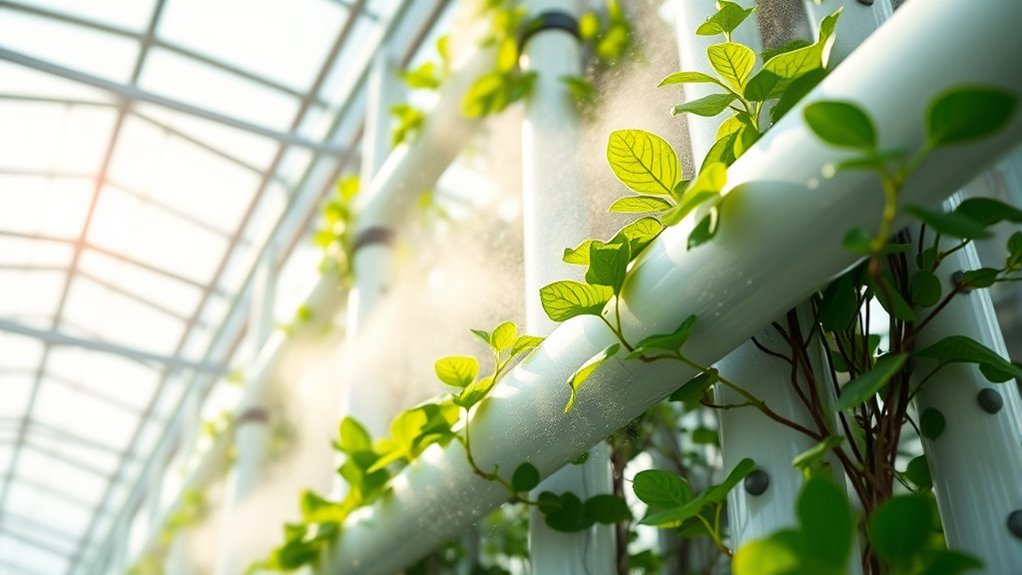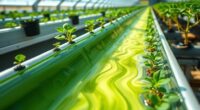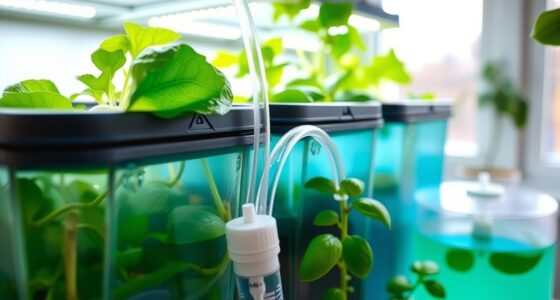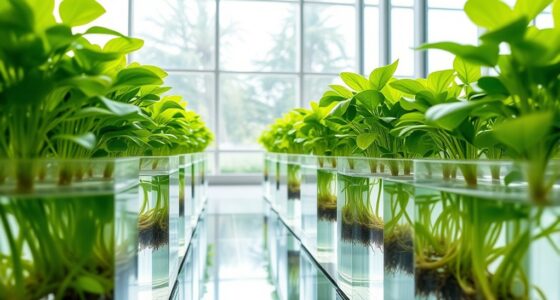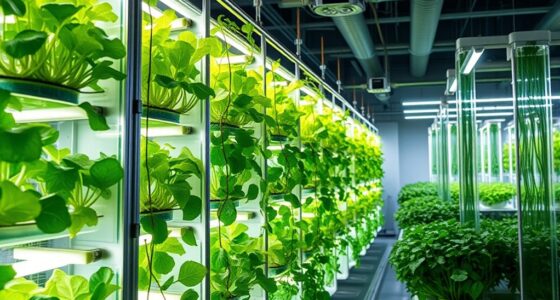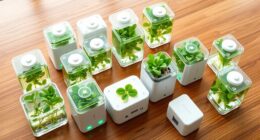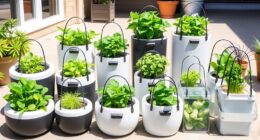Aeroponic towers are innovative systems that grow plants without soil by spraying roots with a fine nutrient mist. They maximize space, especially in urban areas, and promote faster growth with higher yields. To succeed, you need a sturdy setup with proper nozzles, pumps, and nutrient management. Regular maintenance and troubleshooting guarantee healthy plants. Keep going to discover the steps and tips that can help you optimize this efficient, high-yield farming method.
Key Takeaways
- Aeroponic towers use fine mist delivery to maximize nutrient absorption and promote faster plant growth.
- Vertical stacking in towers optimizes space, increasing yields in limited urban environments.
- Proper system design, including nozzles and pumps, ensures consistent misting and healthy root development.
- Regular maintenance, such as nozzle cleaning and nutrient balancing, is crucial for optimal performance.
- Aeroponics reduces pests and soil-borne diseases, leading to higher crop quality and productivity.
Understanding the Fundamentals of Aeroponic Systems
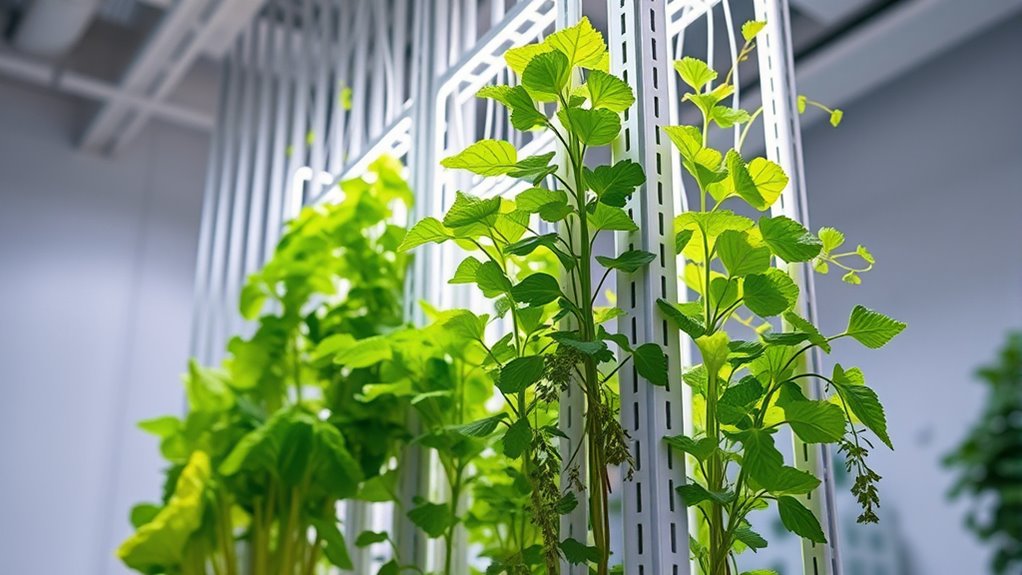
Have you ever wondered how aeroponic systems grow plants without soil? It’s all about delivering plant nutrition directly to the roots through a fine mist. This method guarantees roots receive essential nutrients in a highly efficient way, promoting faster growth and higher yields. Root aeration is a key part of this process, as the system keeps roots suspended in the air, maximizing oxygen exposure. Better root aeration enhances nutrient uptake and prevents root diseases common in traditional soil cultivation. With no soil to block oxygen flow, plants develop healthier, more robust root systems. This technology allows for precise control over nutrient delivery, making sure your plants get exactly what they need when they need it, resulting in ideal growth conditions. Hydroponic systems like aeroponics exemplify this modern approach to sustainable and efficient plant cultivation.
Components and Design of Aeroponic Towers
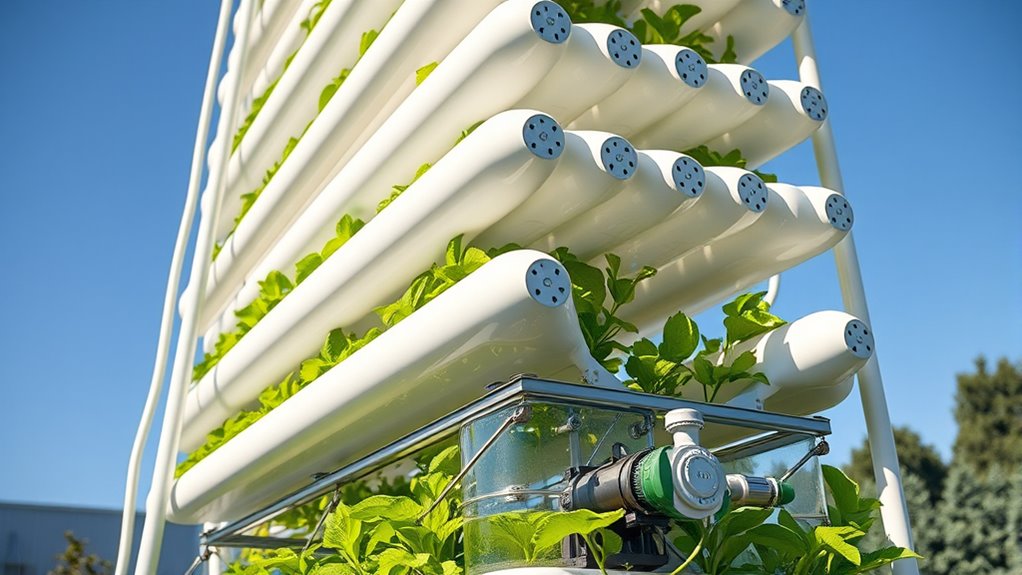
Aeroponic towers are engineered with specific components that work together to create an efficient and effective growing system. The structural framework provides the backbone, supporting the entire setup and ensuring stability. You’ll find vertical pipes or columns that house plant sites, often arranged in a circular or linear pattern. Inside, a nutrient delivery system sprays a fine mist of nutrient-rich water onto the roots, maximizing absorption and growth. Pumps, timers, and nozzles control the misting process, making sure plants receive consistent nourishment. The reservoir holds the nutrient solution, circulating it through the system. Overall, the design emphasizes accessibility for maintenance and scalability, allowing you to customize your aeroponic tower based on space, plant type, and yield goals. Proper application timing of nutrient delivery can further optimize plant health and productivity.
Advantages of Using Aeroponics for Urban and Commercial Farming
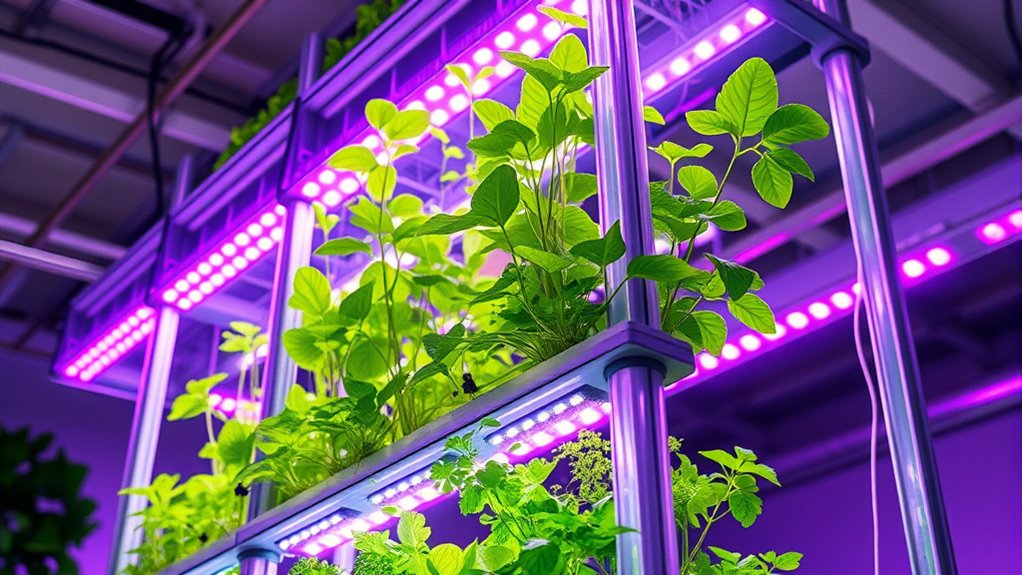
One key advantage of using aeroponics in urban and commercial farming is its ability to maximize space efficiency. Since plants grow in a soilless environment, you can stack towers vertically, making the most of limited space. This setup also helps improve soil health because you’re not relying on traditional soil, which can harbor pests and diseases. With aeroponics, pest control becomes easier, as there’s no soil for pests to hide in, reducing the need for chemical treatments. Additionally, the precise misting system delivers nutrients directly to roots, promoting faster growth and higher yields. This method is ideal for urban environments where space is at a premium and sustainable practices are essential. Overall, aeroponics offers a clean, efficient, and scalable solution for modern farming challenges. Incorporating high-quality projector technology can enhance monitoring and management of these systems, ensuring optimal growth conditions.
Setting Up and Maintaining Your Aeroponic Tower

Setting up your aeroponic tower begins with selecting a suitable location that provides adequate light, ventilation, and easy access for maintenance. Once positioned, assemble the frame and install the spray nozzles, ensuring they cover all plant roots evenly. Fill the reservoir with your nutrient solution, adjusting the concentration based on plant needs. Proper plant spacing is vital—place seedlings so roots don’t overlap, allowing for ideal mist coverage and airflow. Regularly check the nutrient solution levels and replace or top up to maintain nutrient balance. Keep the system clean, especially spray nozzles, to prevent clogs. Use the table below for quick reference:
| Step | Action | Tips |
|---|---|---|
| Location | Choose well-lit, ventilated spot | Easy maintenance access |
| Assembly | Install nozzles and frame | Secure connections |
| Nutrient Solution | Fill reservoir, adjust concentration | Regularly check levels |
Additionally, ensuring proper system maintenance is key to sustaining high yields and preventing issues such as clogs or nutrient imbalances.
Troubleshooting Common Challenges in Aeroponic Gardening

Even with careful setup and maintenance, challenges can arise that disrupt your aeroponic gardening efforts. Pest management is essential; pests can quickly damage your plants and spread in the tower. Regular inspection, cleaning, and natural deterrents help keep pests at bay. Nutrient balancing is another common issue; too much or too little of certain nutrients can stunt growth or cause deficiencies. Monitor your nutrient solution closely, adjusting pH and concentrations as needed. If plants show yellowing leaves, check for nutrient imbalances. Additionally, guarantee your system’s pumps and spray nozzles are working properly to prevent root drying or uneven watering. Proper beekeepers practices, such as maintaining clean equipment and monitoring bee health, can also serve as a useful analogy for maintaining your aeroponic system. Addressing these challenges promptly keeps your aeroponic tower healthy, maximizing your yields and ensuring a smooth, trouble-free gardening experience.
Frequently Asked Questions
How Energy-Efficient Are Aeroponic Towers Compared to Traditional Farming?
You’ll find that aeroponic towers are generally more energy-efficient than traditional farming because they use less water and land. They consume less energy overall, especially if you power them with renewable sources like solar or wind. This means you can achieve higher yields with lower energy costs. Plus, their targeted misting system minimizes waste and energy use, making them a smarter, greener choice for sustainable farming.
What Are the Best Plant Varieties for Aeroponic Growth?
You’ll find that leafy greens, herbs, and small fruiting plants excel in aeroponic towers because of their plant compatibility and rapid growth rates. These varieties thrive in the mist environment, absorbing nutrients efficiently. Think lettuce, basil, and strawberries—plants that grow quickly, maximize space, and respond well to aeroponic systems. By selecting these, you guarantee healthier yields and faster harvests, making your tower gardening more productive and rewarding.
Can Aeroponic Towers Be Scaled for Large Commercial Operations?
You can scale aeroponic towers for large commercial operations, but scaling challenges like maintaining uniform mist distribution and system reliability arise. You’ll need to invest in robust infrastructure and technology to guarantee economic viability, as costs can increase with size. Proper planning helps you optimize performance, reduce waste, and maximize yields. While it’s feasible, carefully address these challenges to make large-scale aeroponics a profitable and sustainable venture.
What Is the Typical Lifespan of an Aeroponic Tower System?
You’ll find that the typical lifespan of an aeroponic tower system depends on proper system maintenance and component durability. With regular upkeep, your system can last 5 to 10 years or more. Key parts like pumps, misters, and filters may need replacement over time, but routine inspections and timely repairs help extend its longevity. Investing in quality components also guarantees your tower remains efficient and productive for years to come.
Are There Eco-Friendly or Biodegradable Materials Used in Aeroponic Towers?
Imagine your garden thriving in harmony with nature, where each element supports sustainability. You’ll find that many aeroponic towers use eco-friendly materials, including biodegradable components that break down naturally, minimizing environmental impact. These eco-friendly materials guarantee your system stays sustainable and reduces waste. By choosing aeroponic towers with biodegradable components, you’re not just growing healthy plants—you’re nurturing the planet, making your gardening efforts both fruitful and eco-conscious.
Conclusion
Now that you’ve mastered aeroponic towers, you’re about to revolutionize your gardening game completely. Imagine growing more food than you ever thought possible, faster than a rocket, with less effort than watering a glass of water. Your urban or commercial farm will become a lush, unstoppable jungle of vibrant plants, defying all limits. Get ready to wield this cutting-edge technology and turn your green dreams into an unstoppable, towering reality!
